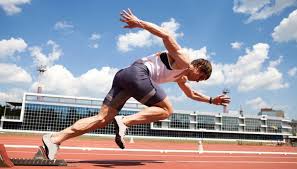
Keep up with the latest news and be part of our weekly giveaways and airtime sharing; follow our WhatsApp channel for more updates. Click to Follow us
Athleticism is often thought of as a combination of strength, speed, endurance, and skill, but there’s far more science behind what makes elite athletes stand out. While hard work, dedication, and passion are essential, the true difference between elite athletes and the average player lies in the interplay of genetics, physiology, psychology, and the strategic application of training.
Understanding the science of athleticism can shed light on why some individuals rise to the top of their sport, while others, despite similar work ethic, never quite reach that level.
1. Genetics: The Foundation of Elite Athleticism
While anyone can improve their athleticism through proper training and effort, genetics plays a critical role in determining an athlete’s ceiling. Certain genetic traits, such as muscle fiber composition, lung capacity, and bone structure, give some individuals a natural advantage.
For instance, elite sprinters tend to have a higher proportion of fast-twitch muscle fibers, which are capable of generating powerful bursts of speed but fatigue quickly. On the other hand, long-distance runners tend to have a greater proportion of slow-twitch fibers, designed for endurance. This genetic predisposition sets the foundation for success in different athletic disciplines.
For further information on sport secret and greatest sport icon click here
Moreover, factors like VO2 max (the maximum amount of oxygen an individual can utilize during intense exercise) and lactate threshold (the point at which lactic acid builds up in the muscles) are also influenced by genetics. These elements contribute to endurance performance and recovery, making them key differentiators in endurance-based sports like cycling, running, and swimming.
While elite athletes are not the product of genetics alone, their genetic predispositions undoubtedly provide a base upon which they can build with specialized training.
2. Physiology: The Body’s Adaptation to Training
Elite athletes are not born with extraordinary physical abilities they develop them through rigorous, specialized training. The science of athleticism involves pushing the body to its limits and triggering physiological adaptations that enhance performance.
When athletes engage in strength training, for example, they stimulate muscle fibers, causing tiny tears that, over time, repair and grow stronger. This process, known as hypertrophy, allows muscles to increase in size and strength, enhancing power output.
Elite athletes often undergo focused strength and conditioning programs to optimize their muscle mass, tendon strength, and joint stability. These adaptations are key to performing explosive movements, such as jumping higher or sprinting faster.
Additionally, the cardiovascular system plays a pivotal role. Elite athletes typically have enhanced cardiovascular health, with a larger heart and a more efficient circulatory system. This enables them to pump more blood (and thus oxygen) to their muscles during strenuous exercise. With each heartbeat, elite athletes can perform at a higher intensity for a longer period of time, which is crucial for success in endurance sports.
For further information on sport secret and greatest sport icon click here
Athletes also benefit from improved neuromuscular coordination. The more an athlete practices a sport, the better their brain becomes at sending signals to their muscles, resulting in greater control, precision, and speed during competition. Whether it’s the perfect swing in tennis or the flawless footwork in soccer, this coordination elevates an athlete’s performance beyond that of the average player.
3. Mental Toughness: The Psychological Edge
Physical prowess alone isn’t enough to make an elite athlete. Mental toughness—often cited as the intangible trait that separates the best from the rest plays an equally important role. The ability to stay focused under pressure, maintain discipline during adversity, and bounce back from setbacks is what defines champions in any sport.
Elite athletes demonstrate remarkable resilience when it comes to handling stress, competition, and failure. Studies show that top athletes have a unique ability to manage emotions like fear and anxiety, often using techniques such as mindfulness, visualization, and positive self-talk to remain composed. Michael Jordan, for instance, was renowned not just for his physical skills but for his unwavering mental focus and his ability to perform when the stakes were highest.
Furthermore, a high level of motivation and a growth mindset are crucial for long-term success. Elite athletes are often driven by an intrinsic desire to improve, as opposed to relying on external rewards or validation. They tend to embrace challenges, viewing failure as a learning experience rather than an obstacle.
The psychology of recovery is also critical. Athletes who can recover mentally and physically after tough performances or injuries are more likely to sustain success over time. Mental resilience helps athletes endure grueling training schedules, tight competition cycles, and the inevitable setbacks they face during their careers.
4. Nutrition and Recovery: The Science of Fueling the Body
In modern sports, performance is increasingly understood not just as a product of training, but also of proper nutrition and recovery. Elite athletes follow specialized diets that cater to their unique energy needs and goals, ensuring that they fuel their bodies with the right nutrients for peak performance.
Carbohydrates, for instance, are the primary energy source for athletes during high-intensity training. Elite athletes often follow carbohydrate-loading strategies to maximize their glycogen stores before endurance events. Similarly, protein is essential for muscle repair and growth, making it a key component of an athlete’s post-workout nutrition.
For further information on sport secret and greatest sport icon click here
Hydration also plays a significant role in performance. Even mild dehydration can lead to decreased endurance, muscle cramps, and impaired cognitive function. Elite athletes are meticulous about staying hydrated, particularly during competitions, as fluid balance can impact performance.
Recovery, both physical and mental, is another critical aspect of athleticism. While training overloads the muscles, proper rest allows them to repair and grow stronger.
This is why elite athletes spend significant time on recovery techniques, such as stretching, massage, sleep optimization, and even the use of advanced methods like cryotherapy or compression therapy. Sleep, in particular, is considered one of the most important factors in athletic recovery, with top athletes typically prioritizing 8-10 hours of rest each night to optimize their performance.
5. Technology and Data Analytics: The Modern Edge
The advent of technology has allowed athletes and coaches to gain deeper insights into their performance and make data-driven decisions about training and strategy. Wearable technology, such as fitness trackers and heart rate monitors, allows athletes to track their heart rate, calories burned, sleep quality, and even muscle recovery in real-time.
Data analytics has also revolutionized sports performance analysis. In sports like basketball and soccer, performance analysts track metrics like shooting accuracy, player positioning, and energy expenditure during games. This data helps coaches tailor training programs, refine strategies, and make in-game adjustments that maximize player effectiveness.
Moreover, technology in biomechanics helps athletes analyze their movements in detail. By using motion-capture systems, they can identify inefficiencies in their technique and make adjustments that enhance performance and reduce the risk of injury.
6. The Role of Genetics, Technology, and Hard Work
The secret to elite athleticism lies in the combination of genetic predisposition, physiological adaptations, mental toughness, nutrition, recovery, and the intelligent use of technology. While genetics provides a base, elite athletes push their limits through continuous and targeted training, smart recovery strategies, and careful attention to the science behind their performance.
For further information on sport secret and greatest sport icon click here
Ultimately, what separates elite athletes from the rest isn’t just one factor it’s the culmination of all these elements working together. These athletes understand their bodies, their minds, and their sport at a deeper level, allowing them to perform at the highest possible level when it matters most. Through years of dedication, hard work, and the application of cutting-edge science, they transcend the limits of ordinary athleticism to become legends of their craft.
Please don’t forget to “Allow the notification” so you will be the first to get our gist when we publish it.
Drop your comment in the section below, and don’t forget to share the post.







